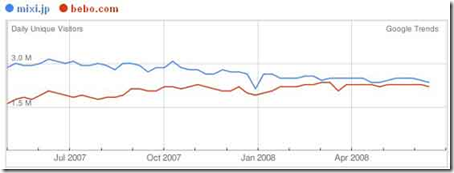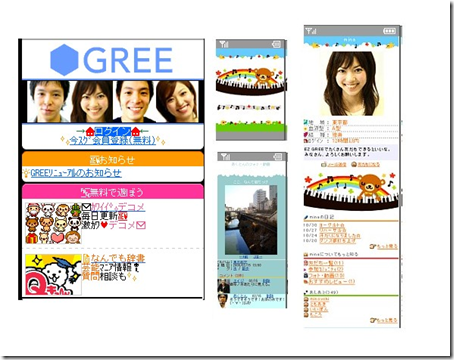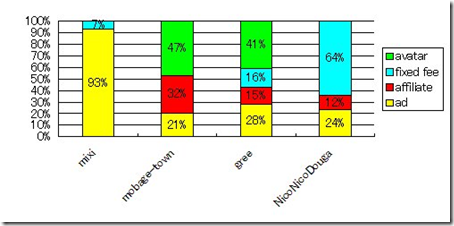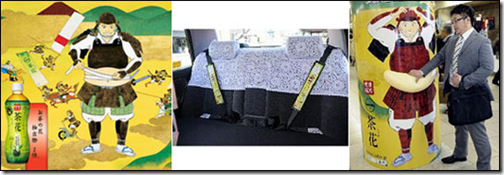Ok, so here is part two of Social Media in Japan – click here to see the first part.
I’m going to try to use a different point of view in this article and I hope you guys like it.
First lets take a look at the business model of four big Social Media Sites in Japan: Nico Nico Douga, Mixi,Mobage-town and GREE.
The data, I found in an article by Fumi Yamazaki in her incredible blog – What’s happening in Japan right now? – that translated from this article – Comparing the business models of Mixi,Mobage-town,GREE,and NicoNicoDouga – that is all written in japanese.
mixi [ja], the largest SNS of Japan depends 93% of their revenue on advertisement.
Mixi, Inc. is a Tokyo-based web company established in 1999, initially as an online job service.
It is now known for its social network service of the same name, which is by far the biggest one in Japan. The site boasts over 19 million members and gets over 14 billion page views monthly (July 2008). The mobile version is more popular than the PC site.
Mixi is only available in Japanese and officially restricted to adults. The service requires an invitation from a member and a Japanese cell phone’s email address for identity confirmation.
Mixi offers typical SNS features such as a “my profile” page, a messaging system, photo and video hosting, a blog/diary function, music sharing, a news section, discussion communities/forums etc. External applications are not accepted. (Techcrunch)
Compared to leading Western social networks, Mixi is rather scarce function-wise (see the screenshot below). However, here are the main country-specific differences why MySpace, Facebook or Bebo don’t stand a chance in Japan:
- Restricted membership to increase the level of safety: Officially, every member must be over 18 years old. Mixi also requires an invitation from a current user and a Japanese mobile mail address to register.
- Blogging and communication as the big ideas: Next to resyndicating external blogs, members excessively write and share so-called “diaries” on the site. Instead of focusing on messaging, status updates and news feeds, Mixi established itself as one of Japan’s biggest blogging platforms. The site also offers more than 2.5 million user-generated bulletin boards.
- Marginal approach to design and structure: It’s almost impossible for users to change the layout and look of the site, which is only available in Japanese. External applications are not allowed. One of Mixi’s most striking characteristics is the scantiness regarding functions and features.
- High level of anonymity: Mixi abides by the preference of Japanese people to generally stay totally anonymous online. The number of members using real names and photos is below 5%. Very important for Japanese users: The so-called ashi ato (footprint) function makes it possible to retrace every visitor on profile pages, improving the feeling of personal security.
Tailor-made mobile version: Users accessing Mixi’s mobile version have been clearly outnumbering those going through PCs since July 2007 (ratio of pageviews in March 2008: 60% mobile to 40% PC).
Mobage-town [ja], the leading mobile SNS/game site .
Subscribers can exchange messages, chat in communities, share music, read pocket novels, and blog, among other things. The site’s “killer feature”, however, is the vast selection of free games that makes most users register in the first place.
Each of the 11 million Mobage-town members is represented by an avatar “living” in a virtual room. Both the characters and rooms can be pimped out with new clothes and wallpaper, for example. In order to do that, users must acquire “Moba Gold”, a virtual currency established by DeNA, by clicking on ads, signing up for affiliate services and inviting new members.
The circular business model has paid off for the company, which is listed on the Tokyo stock exchange (market cap: $2.3 billion). Mobage-town alone raked in $46 million in sales in the first quarter of this year and saw nearly 15 billion page views in June. And yes, this is Japan- and mobile-only. (Techcrunch)
There is also a International version of Mobage-Town called Moba Mingle.
The premise behind MobaMingle is to blend elements of virtual worlds, social networking, gaming and mobile blogging into one integrated concept.
GREE [ja] is a Tokyo-based web services company that was founded in 2004 by then 26-year old Yoshikazu Tanaka. Before, Tanaka was responsible for operating the auctions operations for Rakuten, Japan’s biggest online shopping mall.
The name GREE is derived from a sociological concept called “Six Degrees of Separation”. The company’s flagship product is called GREE Mobile, a mix of social network and free casual gaming platform.
GREE started social network services on the fixed Internet but ultimately lost to Mixi, Japan’s biggest SNS. GREE’s fixed Internet platform is now practically abandoned.
The combination of ads and fee-based sales is working out in today’s weak online ad market: From all of GREE’s sales, 70% comes from virtual items and 30% from ads. That’s a high ratio of virtual sales for a mobile site. In contrast, Mixi is heavily dependent on advertisements (the site generates less than 10% of its revenues through premium accounts and has no avatar system). (Techcrunch)
The biggest difference was that Mobage-town initially did not charge their users(they started doing this but is still a low ratio within the total sales), GREE does (GREE Plus for mobile, GREE premium for PC users) which makes them additional revenue source.
In 2006, GREE received around $4 million in funding from KDDI
, Japan’s No. 2 telecommunications company, triggering a complete realignment in corporate strategy. The site started to focus solely on the mobile web (it’s the default social network for KDDI’s 25 million cell phone subscribers).(Techcrunch)
NicoNicoDouga [ja] is the third largest, but hottest video sharing site in Japan. Their “premium users” are increasing drastically recently, and the fixed fee from premium users has become 2/3 of their revenue. They are still on the red due to heavy network cost, etc.Nico Nico Douga, or “Smiley Smiley Video” in Japanese, is a popular streaming video site in which users can overlay their comments directly on top of the video stream, where they play whenever others watch the video. The site is similar to conventional streaming video clip sites, except it utilizes a third interactive layer on top of the video which plays commentary from the users. Old comments drop off as new ones roll in, unless the user subscribes to a premium account. (Crunchbase)
The user-generated site was established in January 2007 and became one of the fastest-growing web services in the Japanese history. As of May 2008, Nico Nico Douga has over 7 million members (regular and mobile version combined) and gets around 2 billions page views a month. Users uploaded a total of 1.1 million videos.
Nico Nico Douga is mostly frequented by young Japanese males. In contrast to Youtube, most of the content is focused on Japanese pop culture (anime, video-game, footage, Japanese pop music videos etc.).
Nico Nico’s most distinctive feature is that members communicate via short texts inserted on top of the video feeds. Entries are time-synched and flow over the frame from right to left. Using different colors, other users can add comments later in the same way. Some videos are virtually covered with thousands of lines of text, which can be filtered or turned off.
This feature sounds totally absurd but is the main reason why users spend twice as much time on Nico Nico as they do on Youtube. Until today, over 1.2 billion comments were added to the 1.1 million videos on the site, up from 600 million in November 2007. The content mainly consists of Nico Nico-”exclusive” material such as video-game sequences, bizarre comedy clips, anime and user-made footage.
Embedding Nico Nico content is restricted, but this Youtube video serves as a good example of what is typically being contributed:
Niwango
, the company operating Nico Nico, is one of 15 subsidiaries of Dwango
, a media group listed on the Tokyo Stock Exchange.
Nico Nico generates revenue in three different ways. There are currently 200,000 Premium members (up from 90,000 in November 2007) who pay $5 per month for easier access to the site and additional functions. Niwango also sells ad space, accounting for around $300,000 monthly. Sales from affiliate links generate approximately $820,000 per month (official figures for February 2008). That adds up to $2.1 million a month, or a $25 million annualized revenue run-rate. (Techcrunch)
In the chart below we can see how each site makes revenue.
To close this article I would like to talk also about Ameba Pigg.
Ameba Pigg
, a virtual world developed by Tokyo-based Internet giant Cyberagent. Ameba Pigg saw 350,000 registrations since its launch three months ago, with development taking just four months.
Ameba Pigg, which is available in Japanese only, is your typical teenager-focused virtual world with cute avatars, flashy settings and annoying sound effects. There are dozens of virtual worlds like this out there. Nothing special. Watch the video to get an impression of Ameba Pigg’s look and feel. (Techcrunch)
And also this really nice presentation about Asian social media.











